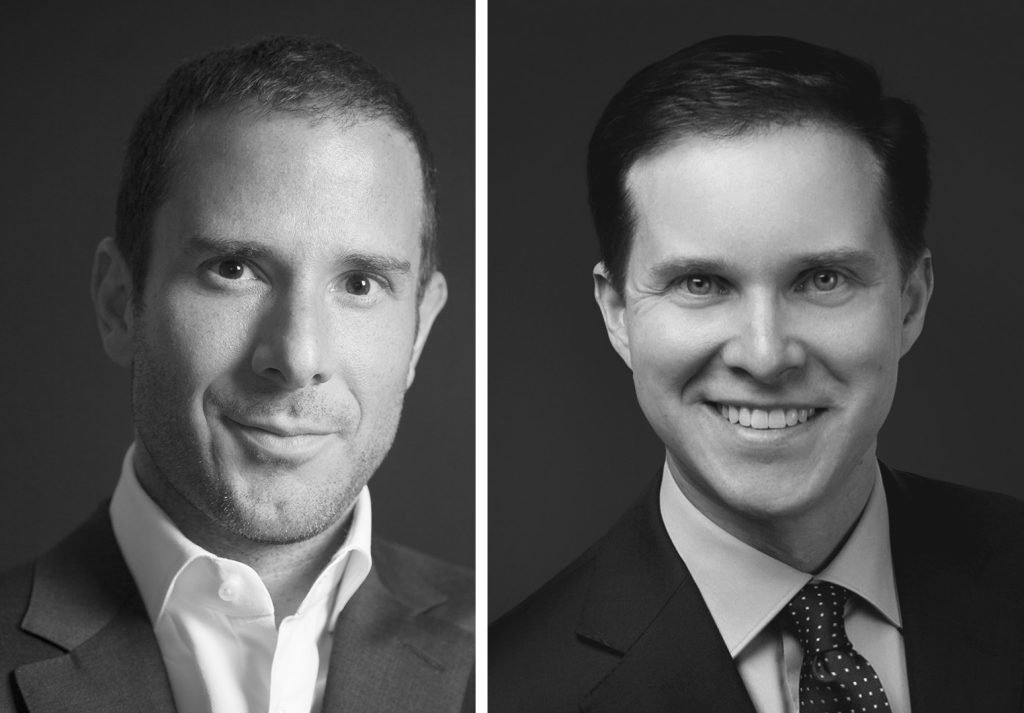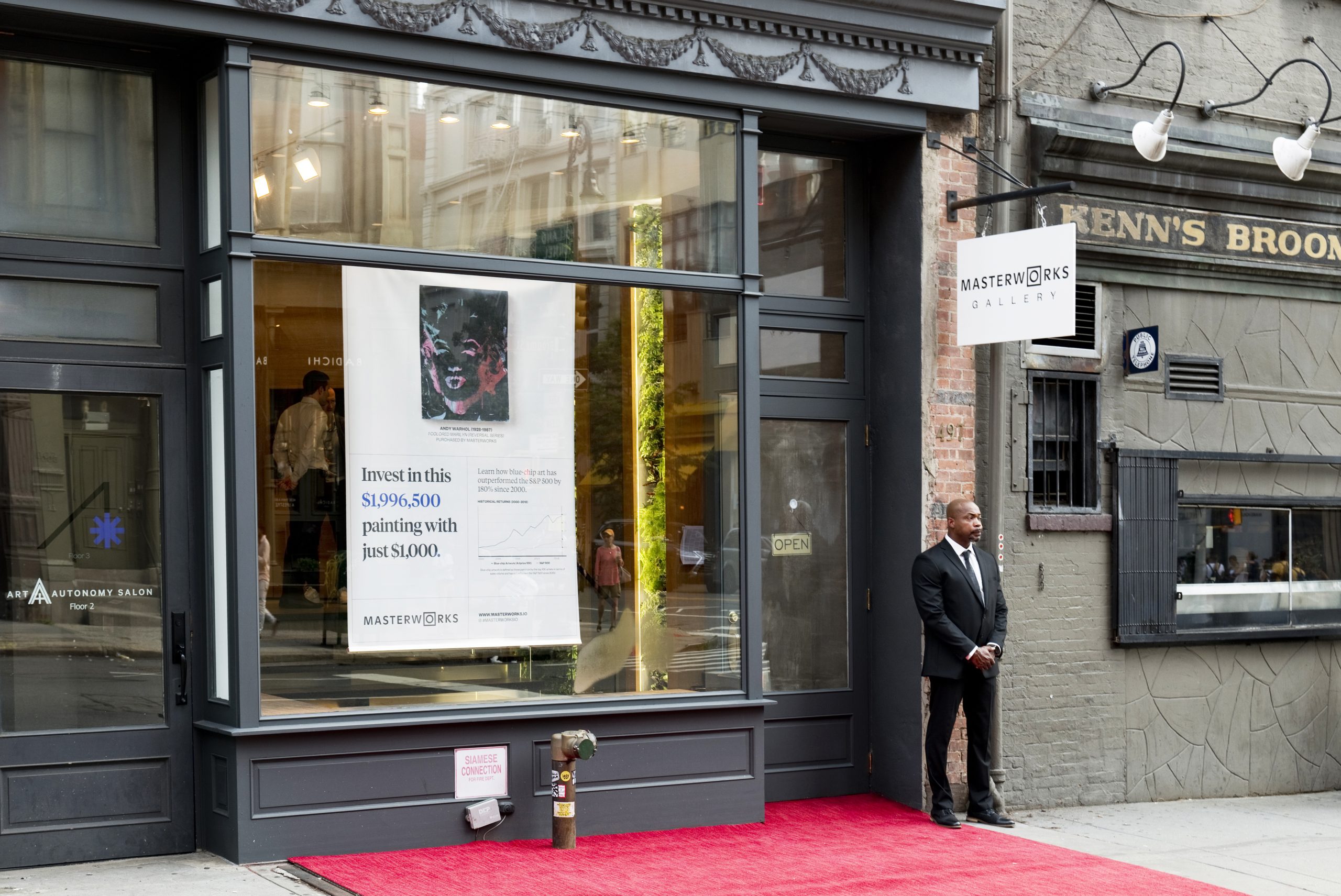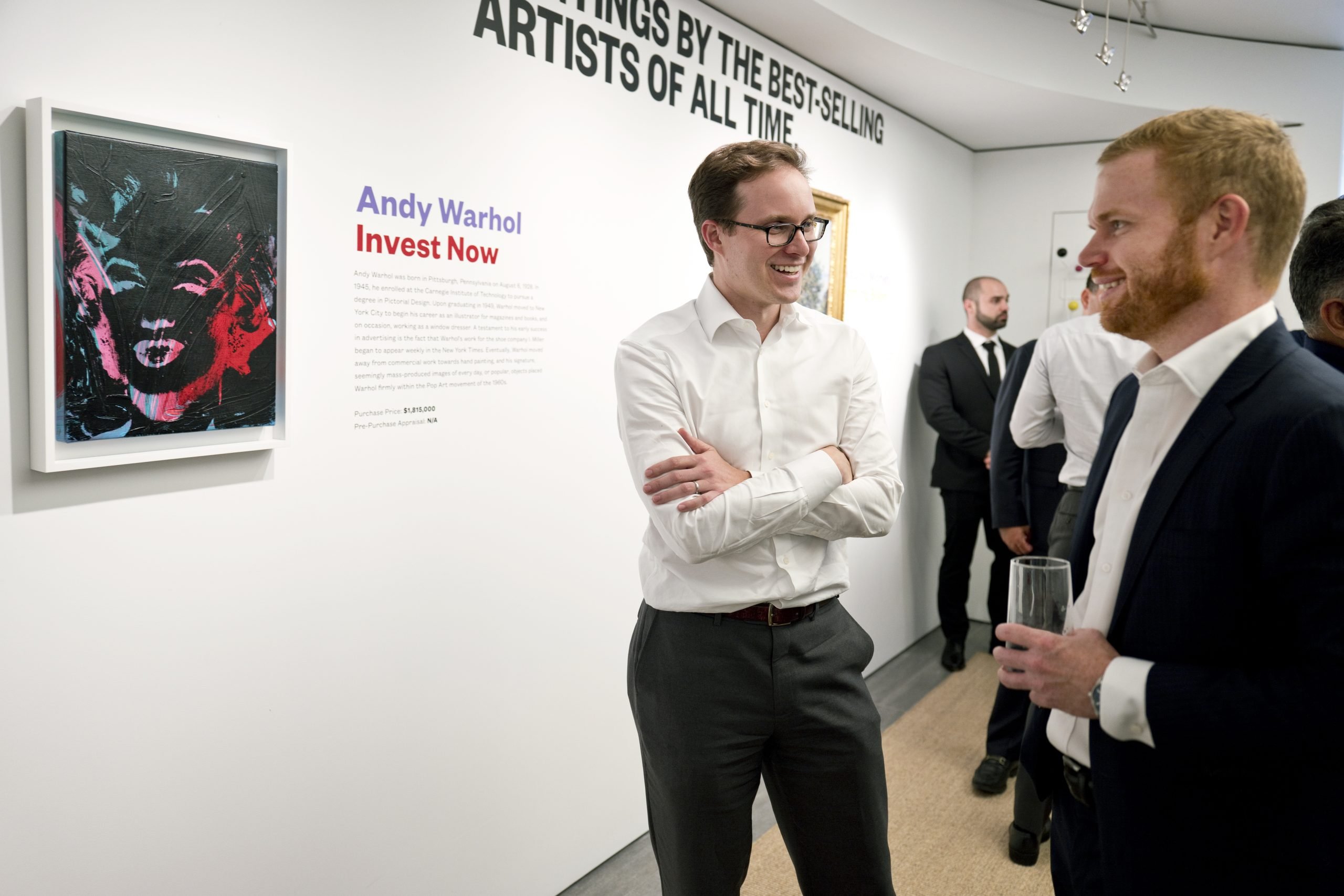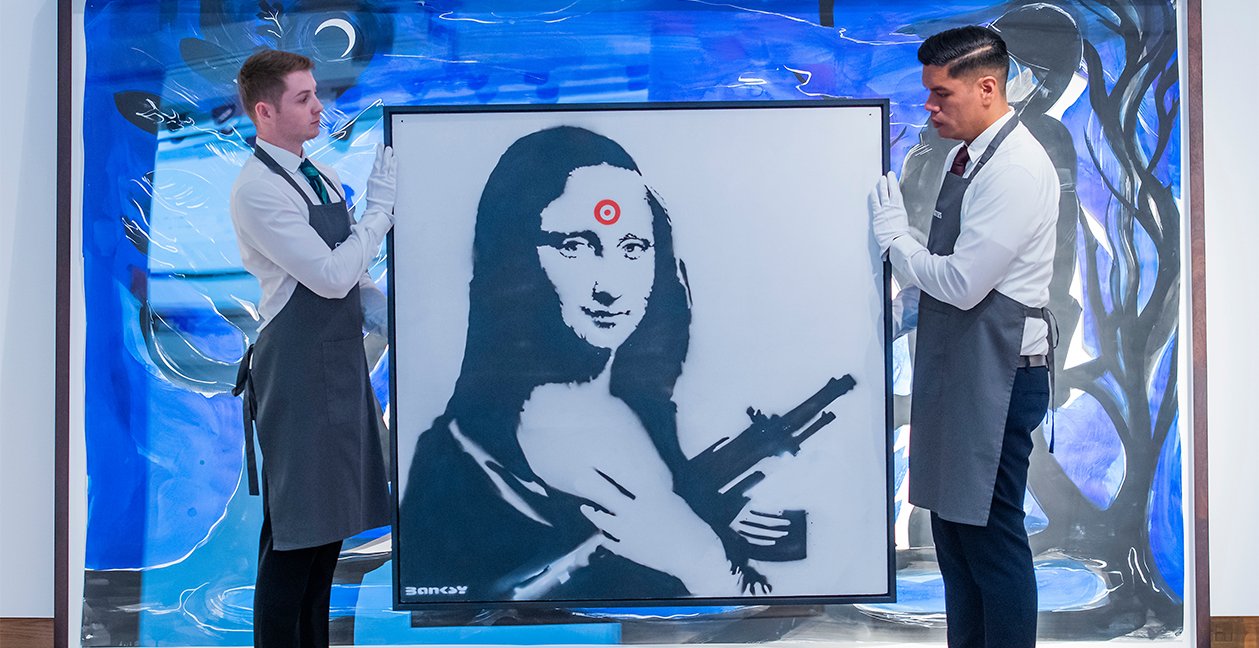Determined to monetize what he says has been a shockingly overlooked piece of the $68 billion global art market, startup veteran Scott Lynn founded Masterworks in 2017 to make investing in blue chip art accessible.
He’s dealing in revered art pieces, but Lynn’s mission is entirely commercial, not aesthetic. Lynn and his colleagues analyze artists’ resale values, target the artists with the strongest demonstrated secondary market performances, purchase their paintings and offer investors shares. This year, Masterworks will also launch a trading platform.
“Art is historically one of the oldest asset classes, but there’s been no way to invest in it unless you’re ultrawealthy. How do we take this asset class, which is historically uncorrelated and outperforming, and make it accessible to almost anyone?” says Lynn.

Private collections, he says, amount to $1.7 trillion in asset value. “In private equities, there’s 9,000 different venture capital and private equity firms; gold, there’s lots of different ETFs and ways to invest,” says Lynn. “In art, there’s really no way to invest other than to buy a painting.”

Over lunch near their office in downtown Manhattan, Lynn and his CFO Nigel Glenday talked about why they’re confident their company will grow, what their greatest challenges are and why they’re steering clear of art world darlings Damien Hirst and Jeff Koons.
Q: What makes Masterworks unique?
Scott Lynn: We were the first company to buy a painting, file with the SEC and sell shares in the painting. That was a financial product we pioneered, and it’s the same structure we’re using today, offering individual painting vehicles where people are picking and choosing the specific artwork to invest in. Overtime, we’d like to roll out portfolio construction tools or fund products.

So the model is that you’re doing an IPO of a painting?
SL: Yes, it’s literally an IPO of a painting. You can read our offering circular on our painting going public on the SEC website. It looks and feels like an S-1.
Which kinds of paintings do you target, and how do you manage risk?
SL: We’re looking at two categories. The first is very established, mid-career living artists that have mid-teen to 20-plus returns and we define them as having moderate risk, which is the specific risk grading that we use in the SEC filings. These are artists doing $15 million to $30 million a year total transaction volume. They’re not a Monet doing $250 million, but compared to your average artist in a gallery, they’re much more stable.
Then we have “blue chip” paintings, created by artists like Warhol, Basquiat and other well-known household names, that we define as having low or reduced risks and produce high single-digit or low double-digit returns.
Nigel Glenday: We’re playing in a secondary market with half a million dollars and up. All of these things are in the evening sales at Christie’s. They are going to be in the major day sales. There’s already established longevity and a secondary market. There are entirely different strategies and risk profiles for higher risk artists that don’t have a secondary market or meaningful appreciation. We frankly think that’s a much less interesting business.
Who are the well-known living artists that have high risk?
SL: Damien Hirst and Jeff Koons have some of the worst returns. With Hirst, people have lost money 57.1 percent of the time. Jeff Koons is another great example: 41 percent of the time that someone’s purchased a Koons, they’ve lost money when they go to sell it. Conversely, people have made money 95 percent of the time with Jean-Michel Basquiat.
NG: The overall way to think about risk is how large each market is. The larger and more established a market is, the more confidence we have around pricing and longevity of the market. We think about that as market cap. And there are cases like Koons, where he has a large market, but the performance is very varied within that. We focus on number of times when people sell at auction, how many times have they lost money? That’s a barometer for us.
Which living artists have proven high returns?
SL: Yayoi Kusama, Kazuo Shiraga, David Hockney and George Condo. Jonas Wood has a shorter track record but has grown 40 percent year over year.
How are you structured?
SL: We structure very similarly to a hedge fund. We charge one and a half percent management fee and 20 percent of future profit. We tell investors that the way to think about liquidity when investing in one of these vehicles is to see these as three- to seven-year illiquid investments. The number one objection we’ve had is that people say that’s a long time to wait. So the core part of our strategy for the past year and a half has been to build out a trading platform that allows people to trade securities in these paintings. It allows for interim liquidity that they otherwise wouldn’t have by just waiting for the painting to sell.
What else will be distinctive about your trading platform?
SL: There will be no minimum investment and no fees. We’re building it as a benefit to existing investors. There is a whole bunch of investors that are interested in investing $100 in these paintings, but we can’t afford to have phone calls with them today because the process is too much, but that won’t exist in the trading platform. Anyone can come in and do it on a self-serve basis.
How do you determine the share prices?
SL: We price all of the shares at $20 a share, regardless of the painting. Each offering amount is tethered to the original cost.
How many investors do you currently have, and how many do you ultimately want?
SL: We have 37,000 investor accounts now and will have 100,000 by the end of the year. It’s growing really fast.

What do you require for people to sign up on your website? Do they have to commit to trade?
SL: We require that everyone speaks to our membership team to make sure they really understand the asset class. One of the things we’ve found is that nobody really knows how to think about investing in art. We want to make sure that before they get access to the platform, they understand the process. There’s some education involved.
Of the 36,000 who’ve signed up with you, how many have invested?
SL: It’s between 3,000 and 5,000. We’re on our sixth offering now. It’s interesting to see how people choose which painting to invest in. Some people are very offering-specific. Jonas Wood’s painting Hammer 5 was a different type of offering for us. He’s a darling of the art market, and his market’s been appreciating 40 percent a year for seven years. Our appraisal was $1.8 million, the offering was $1 million. The data was really good, but he was a name that frankly none of our investors had ever heard of.
NG: Contrast that to the second painting we did, which was Banksy’s Mona Lisa. It also had great numbers, but Banksy has pop culture recognition in a way that Jonas Wood doesn’t.
How important are aesthetics in influencing your investors?
SL: Aesthetics are not important for the majority of our investors. We thought when we started there would be a lot of art people, but the majority of the people are just investors, learning about a new asset class and diversifying their portfolio.
In a lot of ways with art it’s easier to understand than investing in a public equity. Understanding whether Google is over- or underpriced is hard. You have management team, you have multiples, different divisions, different risks, and with paintings you’re looking at how similar paintings have appreciated historically.
NG: The number of data points to understand—how is a Basquiat appreciating over time?—is not dissimilar from valuing a home, looking at appreciation over time. It’s a tangible asset that has opportunities to sell that are only growing, whether it’s art fairs or the number of auctions that are multiplying. You have all these opportunities for liquidity in the market. It’s a common trope that art is somehow super volatile, but that’s not our experience.
Are you concerned about a bubble?
SL: If you look at the art market as a whole, this year $68 billion in art will sell. Art’s been traded for centuries, and outside of real estate, it might be the oldest asset class there is. There are always segments that could be bubbles, but I’d say that’s more galleries selling $50,000 paintings and people thinking they might be worth $500,000 in the future. Those are very speculative. We’re working with million dollar-plus paintings. We’re working with very established artists with track records and we have high confidence in resales.
NG: When you’re going to Art Basel and you’re paying $100,000 for artists that have no secondary market, your resale opportunity might be zero. You have a risk of total loss. That’s where you see bubbles. It’s a much different risk profile.
SL: Of the $68 billion in art that will sell this year, 62 percent of that is created by the top 100 artists in terms of transactions. All of the big names, those artists aren’t going away. If you look at the top 100 artists, the only one who’s consistently produced negative returns is Damien Hirst.
What about the potential for fraud?
SL: It definitely exists, but not in the segment of the market we’re playing in. They’re in the museums, there’s strong provenance, they’re recognized by the artists’ foundations.
The way to think about the game for emerging artists, is that if you’re well-connected in the art market, you understand how to collect them, but that’s not a game that we’re interested in playing. It’s speculative and it’s hard to do that with people’s hard-earned money.
You were saying that you’re the first to compile long-term data on your artists. Tell me about that.
SL: It’s very high level and we’ve published a lot of our research on our website. We’ve taken over 50 years of the major auction catalogues. They’re not digitized. Our team of 25-plus interns has combed through them and found paintings that have been purchased and subsequently resold within the last 50 years. We’ve used the dataset to construct indexes on the art market, to inform us how different segments are appreciating and how individual artist markets are appreciating. Ultimately, it’s guided us around which artists we offer on the platform.
Most of our investors don’t know how to think about returns in the art market. We felt collecting that data was a prerequisite to selling someone a Masterworks investment vehicle. We learned that very early on. At the end of 2019, we published a report with Citibank on art as an asset class. This year we’ll co-publish other reports with other major banks.
We’re starting the education process about the asset class. Most people haven’t asked these questions because they just assumed they couldn’t invest in art that costs millions of dollars. Once we’ve secured the painting, there’s the immediate question of how it’s performing for people who would otherwise just assume they could never invest in it.
How do you get your funding to purchase the paintings?
SL: It’s all balance sheet capital. The business today is funded by me and one small investor. From a regulatory perspective, we have to buy the painting before we file with the SEC, so it all goes on the balance sheet.
Is that daunting?
SL: We’re getting to the point now where we’re selling million-dollar paintings in less than a week, so it’s not a huge concern. Obviously when we started a year and a half ago, we were holding them much longer, but they’re moving quickly now.
How do you identify the right paintings?
SL: We have a purchasing function where we collaborate with our research team. We identify the artist we like, go to market, find the specific examples.
Where are you sourcing the art?
SL: Right now, 100 percent of the art we buy comes from auctions. That gives a lot of comfort to smaller investors who have questions about how we know it’s authentic and how we know we’re not overpaying. At some point we’d like to get away from that.
Once you’ve acquired the paintings, where do they go?
SL: Today we don’t have a good answer for that. The plan is to allow artists’ foundations, artists themselves or institutions to take those paintings on loan. Long term, we don’t want to be in the business of running galleries. We’d rather give them to museums or institutions. For us it’s better because there’s a point of existing in the public domain, and it’s somewhat promotional for us.
Right now, how many paintings are in your possession?
SL: Six. We’re now at the point where we’re selling about one a month. We just launched Alex Katz’s painting Maxine two weeks ago, and as of today, it’s sold out.
You buy the painting, you have investors buying shares in the painting, and then ideally you sell the painting and distribute the proceeds. Who’s the person or institution buying it from you?
SL: We would likely sell the painting privately. We tell people there’s a three- to seven-year hold. We haven’t actually sold a painting yet. Banksy’s Mona Lisa is a great example. We did the offering three months ago and sold the painting to investors in less than a week. Banksy’s Devolved Parliament painting sold at Sotheby’s London for $12 million three weeks later, which was a total coincidence and a lucky break. The value of the painting we offered is up considerably because of that. That painting could theoretically sell much sooner than we expected.
Would you consider then selling it at auction?
SL: We would always consider it, but it’s usually better to sell paintings privately. You can time it better to what’s going on in the art market and time it to artist’s retrospectives.
What’s been your greatest success so far? And your biggest challenge?
SL: This is the 10th-plus start-up I’ve done. The great thing about Masterworks compared to anything else I’ve done is everyone loves talking about the idea. As an entrepreneur, that’s nice to see. It’s easy to understand and get excited about.
The challenge with the business, to be totally honest, is it’s highly regulated. Selling securities in the U.S. is challenging. Every single offering we do is treated as a public offering for a public company. We’re filing 75 pages with the SEC. We’re regulated by FINRA. From day one, we’ve had a general counsel and legal team. It’s not how you would typically think about running a start-up, where you move fast, break things, figure things out, just keep iterating.
Had you anticipated that, or was it a bit of a learning curve?
SL: We anticipated it but I don’t think we understood the extent. The first offering we did was the first time ever a painting had been filed with the SEC as a public offering. It took us a year and a half to get through the SEC. A lot of that was our fault in terms of things that we had in the offering circular that were technically wrong or complex. We’ve found the people at the SEC to be very competent, but the pace has been challenging. A year and a half is a long time.
What’s the smallest quantity of shares someone’s bought, and the greatest? What’s the average investment?
SL: It depends on the painting but the minimum range is between $1,000 and $10,000, so starting at 50 shares. It’s typically around $4,000 to $5,000 per investor, per painting.
Is that where you want to be?
SL: We have found this a very strange product market in that our investors aren’t really big or really small. They’re in the middle. I don’t know why that is. From a marketing perspective, we’re not trying to target those types of people. That’s what I’ve found. The other thing is that the ultra high net worth investor has already considered the art market.
Would you expand internationally?
SL: Right now, we have so much demand domestically, I can’t even think about dealing with international securities law. We signed up 600 investors yesterday. Our best day so far.

How do current events affect you? Are you insulated?
SL: Our prices are correlated to global ultra wealth creation, for better or for worse. So as this international population of ultra high net worth people gets wealthier, our prices go up. Conversely, if something negative happens to that same population globally, our prices could go down. The question is: What policies on an international level could impact that segment of the population? Obviously, wealth taxes are one logical answer. But the art market is global and we think even that risk is fairly small.
Are your investors global as well?
SL: Most people have U.S. bank accounts but that doesn’t necessarily mean they’re living here. Non-U.S. is not a huge market for us, less than 10 to 15 percent of the whole market. Our investors are U.S., but when we go to sell the painting, it goes back to a global market.
Are there competitors to you, or other platforms that are relevant at this level of collecting?
NG: I think the art market is vastly different than cars or wine or watches. This year, the art market is $68 billion. All of those other asset classes individually are less than $1 billion.
There is another platform that is super cool, called Rally Road, which is investing in collectible cars. It’s the closest thing to us, but their average investor is investing $300. It’s more novelty, they’re not investors per se, more car aficionados.
Why don’t you have competitors?
SL: We ask ourselves that every day. It amazes me that we have such a large asset class and nobody’s ever securitized it. I’ve been collecting art for 20 years, all mid-century, 1946 through 1961. People like Pollock, Rothko, Klein, Krasner, De Kooning, Frankenthaler. I think it’s just me coming at it from the perspective of knowing the art market and tech, and those two skill sets don’t usually come together. That’s my best explanation, but it doesn’t make sense. The size of private equity is $3.5 billion and it’s literally more than 9,000 firms investing in it, and in art there’s nothing. That’s why this opportunity is so exciting.
Where do you want to be five years from now?
SL: We’re growing so fast. I think five years from now, we’ll be at one million-plus users. What’s less clear to me is exactly what financial products we’ll offer: single painting vehicles, funds. There’s a lot of demand across the board to invest in art. That’s exciting. We didn’t frankly know that when we started the business. We thought that but we didn’t actually know that. We know that today.






